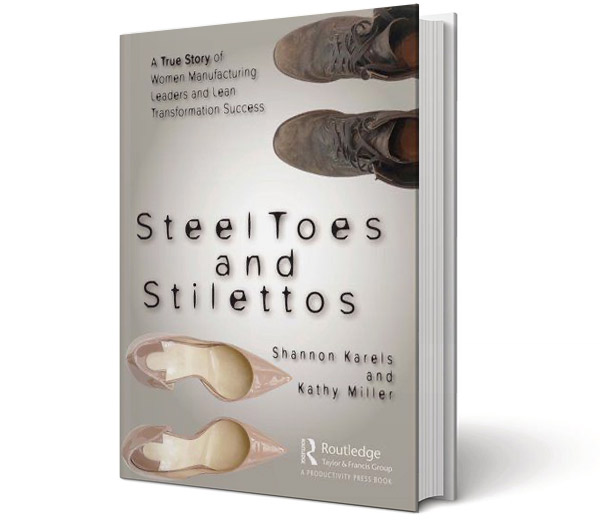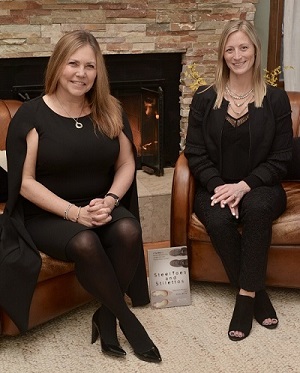Women in supply chain: steel toes and stilettos
New supply chain book tells the story of lean transformation and importance of building inclusive teams

Steel Toes and Stilettos. The book title is irresistible, and a little enigmatic. Is it a fashion guide for female construction workers? A tale about an urban gang like West Side Story, but without the show tunes?
The answer is neither: It’s a book about supply chain management. Specifically, how the authors led a three-year-long lean transformation initiative across three manufacturing plants that led to some pretty impressive results, along with the lessons they learned about building inclusive, high-performing teams.
As to the title, co-authors Kathy Miller and Shannon Karels found ways to excel in the nitty-gritty world of the factory floor wearing their steel toes yet remain who they were off the floor, presumably wearing stilettos.
“When we were working on the lean initiative, we spent a lot of time together in hotel rooms talking about our goals, the transformation initiative and why we worked so well together,” remembers Karels. “We thought we have a great story to share about lean transformation, and the book does walk through that process, but also about the inclusive culture we built, and how we brought people along that drove our success.” The pair has since founded the consulting and coaching firm, OPSisters.
They joined manufacturing at a time when women were a rarity. Miller began on the factory floor of an automotive plant as a 17-year-old coop student. She went on to get an industrial engineering degree from General Motors Institute – now Kettering University - and an MBA from the University of Pennsylvania. She remembers walking onto the factory floor for the first time with her Dad after a 4 hour interview. “It was a whole different world, with people working in pits along the line, and some whooping and hollering at me. My arm was visibly entwined in my Dad’s,” she says. “When they called the next day and offered me the job, my Dad said those catcalls don’t mean anything, and assured me that I’d be fine. He was right. While we’ve all experienced some inappropriate things over the years, once I was working, I didn’t give it a lot of thought.”
She adds that the only time her gender was really noticeable was during break time: The restroom line was for the men’s room and not the women’s room because there were fewer women. Miller was inducted into the Women in Manufacturing Hall of Fame in 2021.
Karels took a traditional route into the industry, earning a supply chain degree from Western Michigan University before spending her first decade in a variety of supply chain roles. Like Miller, she says that she didn’t have “the concept that being a woman in manufacturing was different, but then, I had friends who asked why I’d want to work in manufacturing since I liked to wear cute shoes and I was then wearing steel toes and safety glasses,” she says, which explains the book title. “I just wasn’t focused on it unless someone else brought it up.”
Both women have held supply chain and leadership roles in large publicly-traded companies.
They came together a little more than a decade ago when Miller was the general manager responsible for the P&L at a company with multiple locations in the U.S. and Mexico. She brought in Karels to be her lean transformation manger in the plants and in the office. “We were trying to convert our operations from batch to small lot production and wanted to institute the principles of the Toyota Production System to meet demand with the least amount of waste,” she says. “We had goals to increase on-time delivery, improve safety and productivity and reduce costs.”
Over a period of three years, the model plant had a 74% decrease in recordable injuries, a 57% improvement in profitability, a 16% increase in productivity, a 93% decrease in defects and a 54% decrease in time through the facility. The other two plants had similar results, the pair say.
They also spent a lot of time together on the road, discussing not just the project, but their careers, goals and what had contributed to the success of the project. “There is a framework to lean transformation,” says Karels. “But we also discussed the human element behind a transformation.”
Steel Toes and Stilettos
Adds Miller, “I’ve done work at four multi-billion dollar publicly traded companies, and respect for people is one of the foundational concepts that you’re taught. The companies that do lean well, and sustain the gains over time, are those that make people the foundation of the system.”
Looking at their own relationship, Karels and Miller concluded they had turned their differences – different personalities and different skill sets – into a 1 + 1 = 3 relationship. When they looked at the teams they had assembled in the plants undergoing lean transformation, they realized that diversity, especially diversity of thought and experience, was a common denominator. “In our coaching practice, we get a lot of questions around Diversity, Equity and Inclusion,” says Karels. “The teams we put together were the most diverse in the company, and it happened naturally. We looked for the best person for the job, but we also believed in diversity of thought, so our teams were diverse naturally.”
“We looked beyond pie charts and affinity groups to see what a person has to contribute,” adds Miller.
Another key was creating cross-functional teams, with individuals from across the organization. “There was a lot of resistance to that at first,” says Miller. “What we found is that if you gave those teams a specific objective, like figuring out why people were tripping on the stairs while going to their press operation, and then gave them time, resources and respect, they came together to focus on that problem. We gave them the what, and then trusted that they’d come up with the how.”
While both downplay the fact that they were women working in manufacturing, they recognize that they can be role models for the next generation of women coming into supply chain. “We did this at a time when there were few female role models,” says Miller. “We want to be the face for that next generation of female leaders who have a propensity for math or science. I can’t imagine an industry with more opportunity.”
Says Karel: “What we are trying to portray with the title Steel Toes and Stilettos is that you can be yourself and still be successful in this role, still bring your unique skills and talents in manufacturing.”

Article Topics
Blogs News & Resources
New packaging idea for the cold chain Learn from lift truck service history Two voices of reason on pallet materials 60 Seconds with Bob Trebilcock, outgoing executive editor, Modern Materials Handling The reBound Podcast: How Pitney-Bowes is innovating with autonomous vehicles. Packaging Corner: Be open to change 60 Seconds with Robert Martichenko of American Logistics Aid Network More BlogsLatest in Materials Handling
Vehicle-mounted computers: Beyond rugged New packaging idea for the cold chain Autonomous mobile robots (AMRs) offer modern solution to challenges of traditional farming Hyster-Yale Group provides students with real-world AI experience in 2024 Kellogg Design Challenge KION Group’s board extends CEO Rob Smith’s contract by five years UniCarriers Forklift joins Quality Equipment in opening celebration of new location Largest Automate on record opens in Chicago on Monday May 6th More Materials HandlingAbout the Author
Subscribe to Materials Handling Magazine

Find out what the world's most innovative companies are doing to improve productivity in their plants and distribution centers.
Start your FREE subscription today.
April 2024 Modern Materials Handling

Latest Resources











